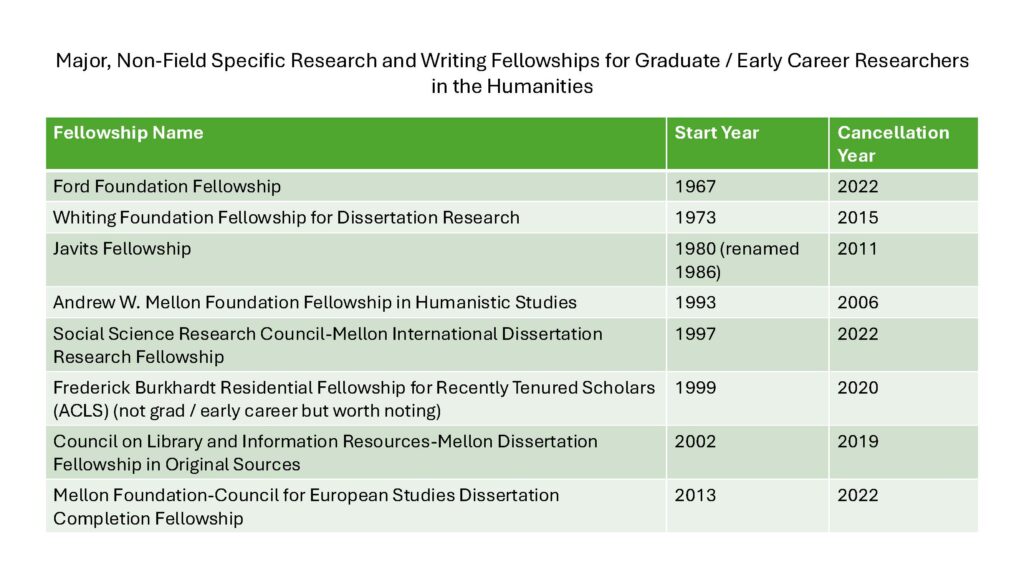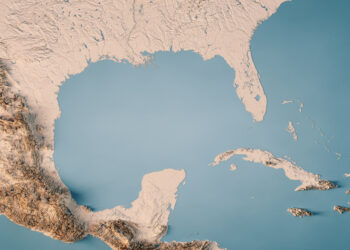You can pick your metaphor. Is humanities research the dog in the burning house meme, or just a feature of the current dumpster fire of the academic-government-world order? Maybe both and more, but most importantly and usefully for understanding where we are and how we got here, the humanities have always been the canary in the coal mine of the full knowledge industry. A truly catastrophic decline in permanent academic jobs in the Humanities will not be left at the Humanities (depriving all of us of the research that fully employed expert scholars would have produced); the winnowing of research support even for fully employed scholars, and the narrowing of venues for the public benefit of the work impoverishes us all. But how can we get our brains around the enormity of what’s happening/ happened?

Last May, Asheesh Siddique, Associate Professor of History at the University of Massachusetts Amherst, Robert Townsend, Director of Humanities, Arts, and Culture Programs at the American Academy of Arts and Sciences and co-director of the Humanities Indicators Project, and I offered a session at the Society for Scholarly Publishing annual meeting on “The Humanities Crisis: What to Know and (Maybe) What to Do.” Almost immediately after we stepped out of the conference room we faced what is now a snowballing crisis across academia and it’s been frankly hard to find time to step back and assess where we are now, never mind where we’re heading.
But what seems clear in the US (our major focus), but also in the UK, the Humanities were indeed a harbinger, and humanists a chorus of righteous and correct Cassandras. What was undermining the Humanities was not simply an argument about what or which disciplines are foundational and which are luxuries, under the guise of a discourse around which college majors would better equip students for careers and offer them incomes. What was undermining Humanities research was not a wholesale turning away from the value and values of a college education. Rather, the Humanities were and are experiencing the impact of two blunt forces: a great forgetting about the role of higher education in driving the American economy and the expansion of opportunity since World War II, and the perilous invisibility of Humanities expertise in a period when expertise of all kinds is vulnerable beyond reasonable scrutiny.
This potent combination, which some argue has been politically constructed and certainly inflamed, was never going to be only directed at the Humanities. It has come for science because it was never just about the Humanities, but about how we assess American progress through infrastructures of new knowledge and its application. As almost 2000 members of the National Academies of Science, Engineering and Medicine have signed an open letter stating that the administration in Washington has opened a “war on science” (not NASEM itself, which is hewing to the position that science is not political), agencies and their grantmaking are being hobbled or shut down.
[Yes, there are debates to be had about the costs of higher education, which has been largely driven by the defunding of public higher education. Yes, there are debates to be had about how and whether support for higher education is partisan and research funding is political (there is data on this that may surprise you). And yes, there is a reasonable question about how much the expanding opportunity of higher education to include women and people of color provoked a cultural and political backlash. And that the Humanities stand opposed to a world inclined to profit. Not to mention the global political economy. But this is a blog post, people, one that asks us to be attentive to even larger contexts but, for the moment, not distracted by them.]
Our session was titled “What to Know” and cheekily subtitled “(Maybe) What to Do” about these unfolding and multidimensional crises. What we offered was in large part that knowledge itself – simply understanding some basics that in our hectic and often siloed world can be elusive, even invisible or submerged – is imperative. We must know, and share, what information we have about the vital role and situation of Humanities research and infrastructure across the country, and the impact in communities across the country. Having taken this work and these institutions for granted for too long, it’s never been more important to fully appreciate their value.
Asheesh, Rob, and I gathered and shared some data and resources back in May, and I’ve added some more recent and relevant information here within 4 categories: infrastructure, funding, employment, and public impact. Every one of these categories could be mapped and argued for the sciences, of course. But Humanities work has always flown below the radar, less attractive to the kinds of “big discovery” media narrative or of the kind of immediacy of public health research, for example. Yet we also know that Humanities work is essential for individual, community, and civic health.
Infrastructure
In 2020 I wrote a short piece about the low cost high return on investment (ROI) of Humanities research infrastructure, asking “will we sell it short?” The core of Humanities research is libraries and archives. Like much about Humanities work, its infrastructure covers both expert research and also public institutions and venues.
This month the Institute for Museum and Library Services has been slated for closure. The New York Times referred to the IMLS as “obscure” and perhaps even researchers haven’t fully appreciated the importance of this agency, but librarians and archivists know it well. Its impact is experienced far and wide, and its absence will be, too. Artnet reported that not only is its entire staff placed on leave but that existing grants will be canceled.
IMLS makes grants and offers programs to support libraries and museums all over the country; it is the largest source of their federal support. An Interactive map shows where those grants are – or were – across the country: www.imls.gov/mapwww.imls.gov/map. IMLS covers for example 1/3- 1/2 of state library agency budgets. Do you know what your state library agency does? Here where I live in Rhode Island, our state library agency covers programs to ensure our public libraries have online services, interlibrary loan, disaster planning, & data collection among other things.
Funding
In the United States Humanities research has been funded by a combination of public and private sources, but the never broad avenues for direct support for scholarly projects has considerably narrowed over the last years.
As Asheesh’s slide from our May SSP panel showed, a number of critical supports for research ended or were redirected in the last decade:

At the same time, in the United States comparing direct federal support for STEM versus Humanities scholars is striking, even if we separate out federal research spending through agencies such as the Department of Defense, Department of Energy and the National Institutes of Health. The National Endowment for the Humanities is:
…the only federal agency in the United States dedicated to funding the humanities. Since its founding in 1965, NEH has awarded over $6 billion in grants to museums, historic sites, colleges, universities, K–12 teaching, libraries, public television and radio stations, research institutions, independent scholars, and to its humanities council affiliates in each of the nation’s 56 states and jurisdictions. Panels of independent, external reviewers examine and select top-rated proposals to receive grants.
Let us pause there. Since 1965 NEH has distributed in grants… $6b. The FY24 budget for the National Science Foundation alone was $9.06b. (And for NEH in FY24, $211m.)
Perhaps more tellingly, the NEH funding rate for scholars is 7% whereas for NSF grants at last report it was 25 or 26%. So the NEH budget has been stretched incredibly tightly across a struggling sector. As of this week, we learned that the NEH, too, will be slashed, with staff placed on leave and then fired, and grants cancelled as per IMLS.
Employment
One of the important reports that the Humanities Indicators Project of the American Academy of Arts and Sciences (that’s Rob’s outfit) has produced is a compelling, state by state look at Humanities majors and jobs data. I wrote about this, and about the state by state info guide that you can access to see the details, in late 2023. At the time, I linked this project, its data, and the story it tells about how and why Humanities majors are good for career outcomes, to a lot of contrary narrative and policy. In particular, why would you cut Humanities majors at your public higher ed institution in the face of this information? This was as we were all just digesting West Virginia University cutting its math department along with other superfluities such as linguistics and music.
A key argument about why a government can and should cut funding to arts and Humanities is because this stuff is just luxury goods. Non-essentials. Leaving aside the clear cultural and social benefits (which we know from a lot of HSS research, of course), the Humanities contribute economically. In the wake of the threat to IMLS, it’s useful to look at some of the data that, for example, the American Association for Museums and other advocacy and industry organizations have long been compiling.
A couple of examples from the AAM:
-
In the United States, museums support than 726,000 jobs.
-
Annually, museums contribute more than $50b to the U.S. economy, and $12b in tax revenue.
Public Impact
Humanities research, like all research, reaches the public by a variety of means. Among the most direct is in the works of history, literature, and more that people encounter in books, essays, exhibits, memorials. Two years ago, a special issue of the journal Daedalus, the journal of the American Academy of Arts and Sciences, for which Rob served as one of the guest editor, on “The Humanities in American Life,” included a study from the collaborative group 4Humanities.org on their project WhatEvery1Says. This was a project to explore the question of the persistence of the Humanities crisis perception – how is it that people talk about and think about the Humanities – or at least what could topic modeling reveal to us?
Two findings struck me as important. One is that the Humanities per se barely register at all in the media except in so far as some specific interest items get called out. You know the kind of thing. The media will cover some new archival find or interpretation, but rarely the research that undergirds it. No, as the authors nicely put it, the humanities index the ordinary stuff of life. They are either too specific – this very one thing about a narrative or some artifacts – or the most abstract sense of significance – what it means to be human. And it is hard to make a budget on that.
In the same issue historian Keith Wailoo surveyed the field of the Medical Humanities. Wailoo pointed to how the field has emerged, powered first by the idea that training doctors needed to include a bit of humanizing. Literally, to improve “bedside manner,” young doctors should take some humanistic coursework. But pretty quickly Medical Humanities came to encompass a better understanding of how medicine has long been shaped by human presumption and bias, and how Humanities research could inform better medicine. The result? Better patient health outcomes – not just kinder doctors, but smarter, better informed doctors – and better medical research.
We may be past the point of no return, but at a minimum we ought to all be equipped with the information we need to assess where we are, and what we’re losing when we fully cashier robust support for Humanities research. The Humanities are us.
**With many thanks to Asheesh and Rob for our SSP session, and our ongoing conversations.
Discussion
3 Thoughts on "The Humanities as Canary: Understanding this Crisis Now"
Thank you, Karin. And absolutely, the humanities *are* us. All of us. What has always struck me about NEH is its dedication to inclusion. And by that I mean not just inclusion of people historically marginalized by race or gender, but the attempt to understand a tapestry of American life that includes privileged and less privileged, white and black, Midwestern and Coastal, North and South, plains and mountains. That has made it different from private funders like Mellon, although its frequent partnership with that estimable foundation has modeled how government can operate more efficiently by leveraging public/private partnerships. For my state, Michigan, I know NEH most recently for its work with historians in the Upper Peninsula to tell the stories of the mining communities that supplied a disproportionate percentage of America’s armed forces in WWI and II. These tough white men and women’s stories have helped me understand some of the marginalization and anger that rural communities in the Midwest have felt for us in wealthier urban centers more recently and to want to do better by my neighbors. Undermining NEH is yet another attempt to divide us, to rip the social fabric that helps the USA be the space of opportunity for all that I came to in my 20s in reaction to the claustrophobic classism too often typical of the UK. What’s happening this week is such a shame. I’ve written to my representatives with the tools that the National Humanities Alliance makes so easy to use. I hope other readers of the SK will too.
Thank you so much, Charles. Beautifully said. I think the NEH for All tools (https://www.nehforall.org) are great at showing how far the NEH reaches across the country both in its direct grants and in the work that the state councils do. It is gutting to think that this work– that by some counts more people than experience sporting events enjoy– is so undervalued as to be this vulnerable.
That’s well said, Charles.
Re: “Undermining NEH is yet another attempt to divide us…,” I would say the same about the closure of IMLS, which is part and parcel of the culture war attacks on libraries and librarians of the past few years. It’s an attempt to convince people further that cultural institutions are not only irrelevant but also somehow dangerous to the sort of new order that they are trying to create. (Though I suspect these attacks may also serve to mask a more nefarious motive, which is to undermine information access models that provide information freely and free from surveillance.)



